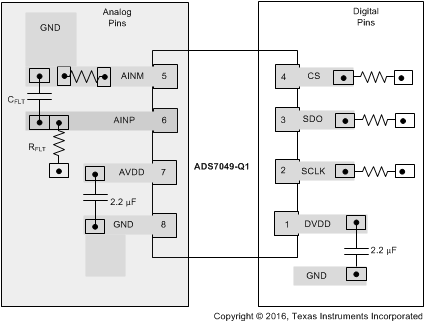JAJSCL4 November 2016 ADS7049-Q1
PRODUCTION DATA.
11 Layout
11.1 Layout Guidelines
Figure 44 shows a board layout example for the ADS7049-Q1.
Some of the key considerations for an optimum layout with this device are:
- Use a ground plane underneath the device and partition the printed circuit board (PCB) into analog and digital sections.
- Avoid crossing digital lines with the analog signal path and keep the analog input signals and the reference input signals away from noise sources.
- The power sources to the device must be clean and well-bypassed. Use 2.2-μF ceramic bypass capacitors in close proximity to the analog (AVDD) and digital (DVDD) power-supply pins.
- Avoid placing vias between the AVDD and DVDD pins and the bypass capacitors.
- Connect ground pins to the ground plane using short, low-impedance path.
- Place the fly-wheel RC filters components close to the device.
Among ceramic surface-mount capacitors, COG (NPO) ceramic capacitors provide the best capacitance precision. The type of dielectric used in COG (NPO) ceramic capacitors provides the most stable electrical properties over voltage, frequency, and temperature changes.
11.2 Layout Example
 Figure 44. Example Layout
Figure 44. Example Layout